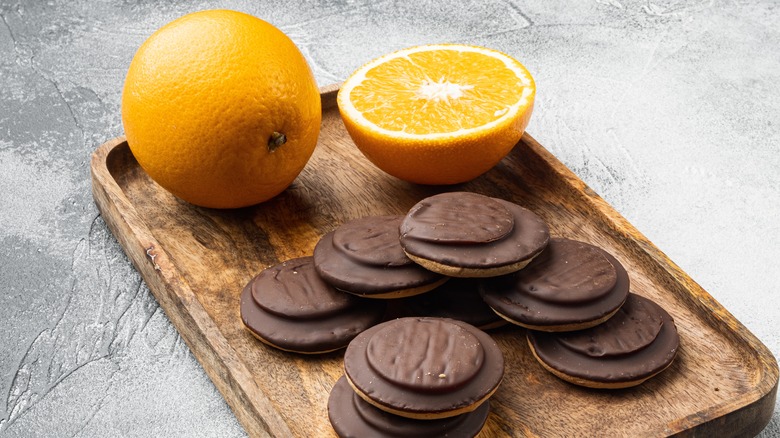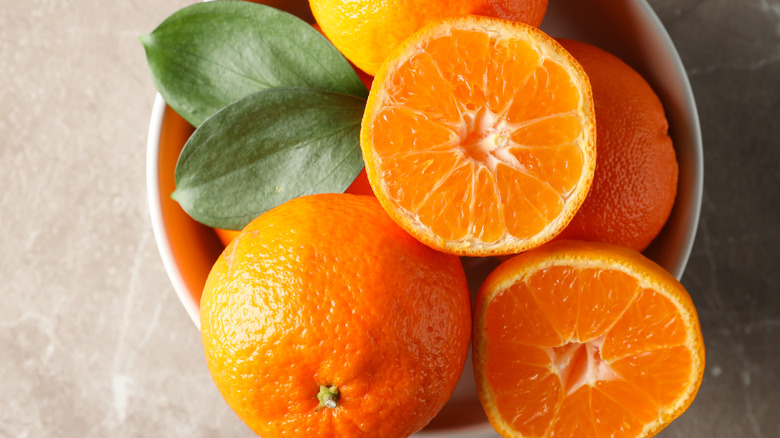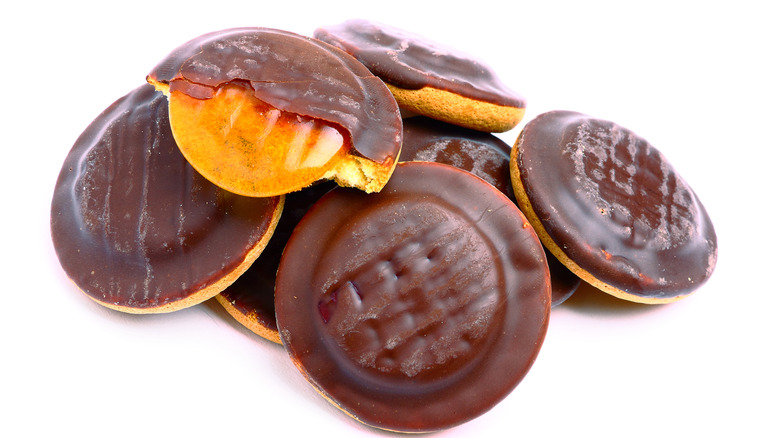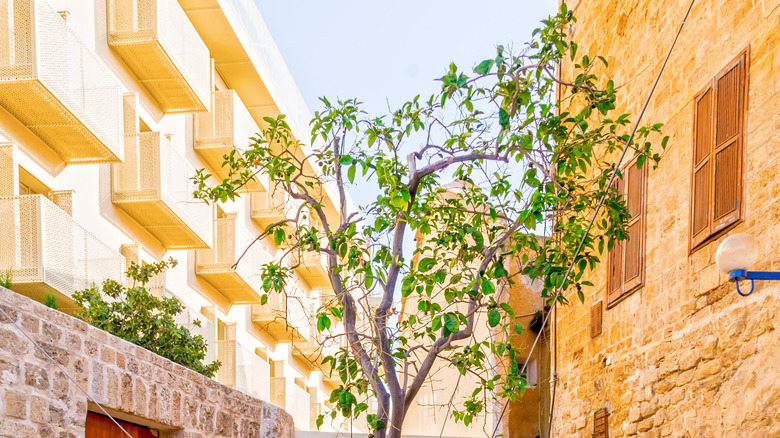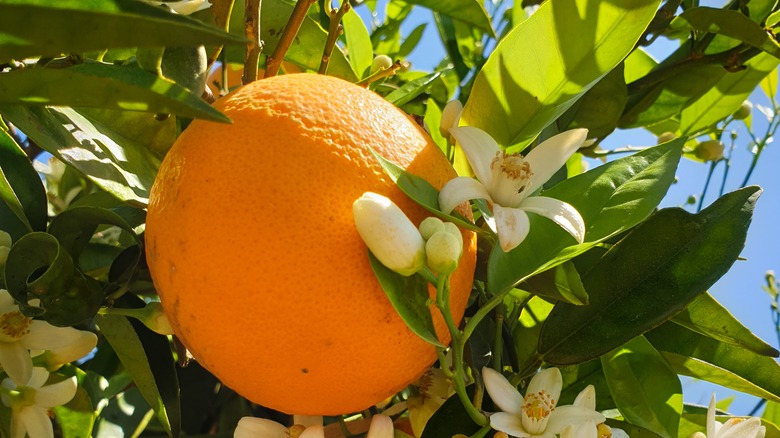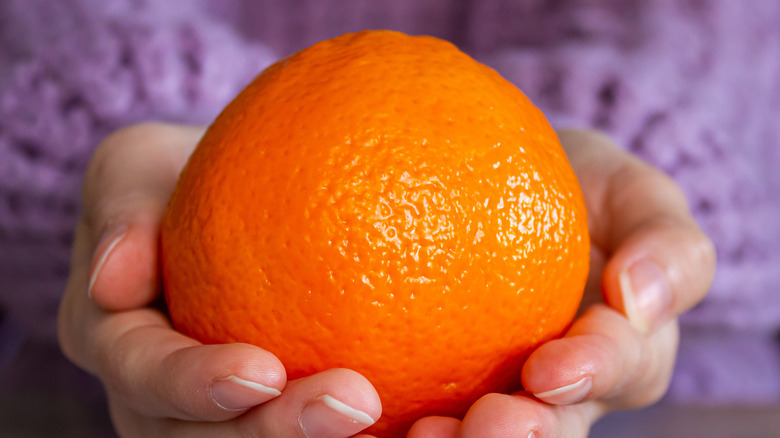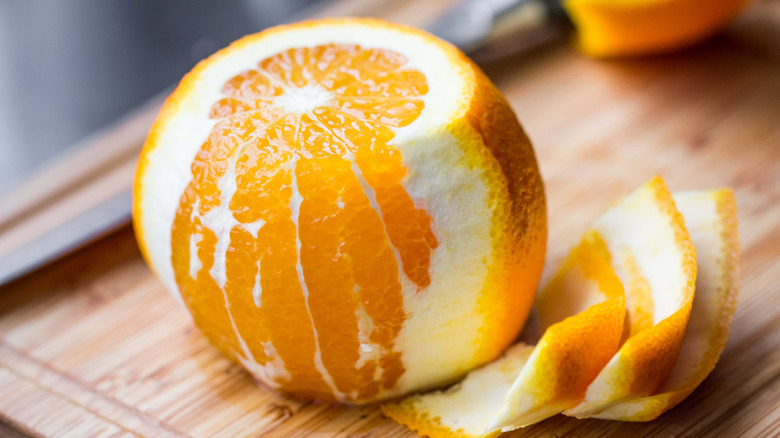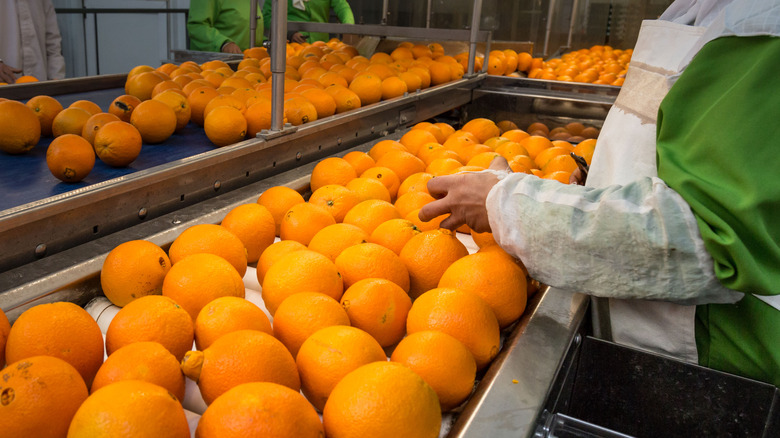What Are Jaffa Oranges And Are Jaffa Cakes Made With Them?
Sweet oranges (Citrus sinensis) have been a favorite treat throughout human history. Said to have been brought to the Middle East from mainland Asia by the Persian Empire in 100 BCE, and introduced to the Romans soon after, multiple cultivars of this succulent citrus spread throughout the Mediterranean, North Africa, and Arabia. By the Middle Ages, some of the world's most recognizable sweet oranges were being produced in Spain. Seville and Valencia oranges are equally famous, the former being the primary ingredient in that most famous sweet citrus spread: marmalade.
Yet, there is one sweet orange that has a history more dramatic and culturally significant than any other. Though somewhat faded into obscurity in the modern citrus market, the Jaffa orange (Citrus sinensis "jaffa") was once so popular and beloved for its quality and sweetness that it was, and continues to be, the standard by which all other oranges are judged.
First grown in the ancient city of Jaffa, now part of Tel Aviv in modern Israel, Jaffa oranges symbolized the region's dichotomy, serving as a point of pride for both Arabs and Jews. At their height from the late 19th to mid-20th century, Jaffa oranges represented an enormous commodity from this part of the world. So popular were these oranges that they found themselves on the tables of royalty and commoners alike, albeit in drastically different forms.
What are Jaffa oranges?
Jaffa oranges are named after the ancient city of Jaffa. Though part of Israel today, Jaffa was part of Palestine during the Ottoman Empire in the 18th century and was known to produce citrus fruit of unique quality. In the middle of the 19th century, a citrus grower named Anton Ayub noticed that one of his trees was growing a larger ovular orange with thick skin. When peeled, he found it produced very few seeds and had exceptionally sweet flesh. Ayub took a cutting from this tree and grafted it onto another tree. He labeled his new tree the Shamouti orange.
The Jaffa label didn't land until the 1870s when an export firm branded the oranges with a moniker to honor their home. Jaffa oranges travel exceptionally well without spoiling, owing to their thicker skins. Once exports began from Palestine, the oranges' popularity skyrocketed. One even made its way to the table of Queen Victoria.
Their popularity peaked in the years between World Wars, with Jaffa oranges accounting for three-quarters of all citrus produced by Arab and Jewish orchardists. After the State of Israel was formed in 1948, Jaffa oranges simultaneously became a symbol for the Arabs of their forced exodus and a symbol of prosperity for the new Jewish state. Though the Jaffa orange's success dwindled in favor of sweeter, easier-to-eat tangerines, its legacy lives on in several ways, one distinctly British.
Enter the Jaffa Cake
Over in the United Kingdom, Jaffa Cakes are a sensation. First produced in 1927 by famed biscuit maker, McVitie's, a Jaffa cake — a cake, not a biscuit — is a small ring of sponge cake with a middle layer of jam and a top coating of chocolate. An instant classic from when they hit the shelves, Jaffa Cakes have retained such popularity in the United Kingdom that fans of the snack were up in arms over the change in packet size from 12 cakes to 10. That's how seriously people love their Jaffa Cakes.
The question is, are the cakes made with Jaffa oranges? The answer is both yes and no. The sponge is not made with Jaffa zest or juice; the jam filling is where the citrus flavor comes in. According to the manufacturer, Jaffa oranges were once used to make the jam. This makes sense, as the Jaffa craze was at its height in 1927 between the World Wars.
However, a different recipe flavors the jammy core of a mass-produced Jaffa Cake today. The sweet citrus jam is derived from apricots flavored with tangerine oil to provide that signature orange kick. So why continue to call them Jaffa Cakes? Well, their popularity is for one thing. It would be difficult to back a name change of a product that's been a staple for nearly a century and has legions of fans who take packet size as gospel.
How are Jaffa oranges grown?
The Jaffa is a scion variety of orange. Scion orange varieties typically contain low acidity, thin peel, and light juice. The Jaffa fits all of these categories except for one. Jaffa peels are notoriously thick and can be rather tricky to peel unless. The thicker peel likely comes from the fact that Jaffa oranges are a mutated variety of Egyptian Baladi oranges. Surprisingly for a citrus fruit, Jaffa oranges are not great fans of the heat, at least not humid, tropical heat. Jaffa oranges grow best in environments that mimic the arid conditions of their homeland.
Another trait of Jaffas is that they can only be cultivated via grafting. This means that a cutting of the parent tree with vegetation is taken to be grafted onto another tree. This is performed by cutting into the host tree at an angle, inserting the cut branch, and the connection gets wrapped up and secured to a support stake. The connected plants will lead to a tree that can grow up to 20 feet tall and provide substantial yield year after year. It is estimated that, in 1970, over 100,000 acres of orchard in Israel were dedicated solely to Jaffa oranges.
Jaffa oranges vs. Valencia oranges
Spain, to date, is the largest orange producer in Europe. As they technically share a coastline along the Mediterranean Sea, Israel and Spain are uniquely poised to be rivals of one another. Unfortunately for Israel, Spain has a history of empire on its side. Therefore, Spanish oranges are widely cultivated throughout much of the southeastern United States, Mexico, and California.
The Valencia orange comes to mind as one of Spain's most famous products. Likely originating from China, this particular variety of sweet orange grows abundantly in the area surrounding the city of Valencia in southern Spain. The orange is so symbolic of the city that its blossoms are frequently used to arrange wedding bouquets for brides. Known for its sweet-tart flavor, Valencia oranges are the most sought-after for juice. Indeed, in Florida, an early North American Spanish territory, Valencia oranges account for over half of the state's fruit production.
By contrast, the Jaffa oranges have had far less reach. Though it was highly popular in its heyday, it has never been widely cultivated outside of Israel. They're also much trickier to consume. A Jaffa's skin, for one thing, has been determined by some to be too difficult to peel, whereas a Valencia has a much thinner peel and is widely favored by chefs and home cooks for its juicing properties. While Jaffa oranges can be juiced, they are not nearly juicy enough to offer the same yield as a Valencia.
What do Jaffa oranges taste like?
Though we've made a lot about the difficulty of the peeling process, the reward awaiting your patience is more than worth the effort. Jaffa oranges are extremely sweet. Somewhat similar to the rival Valencia orange in terms of the sheer impact of citrus that first greets your tastebuds, the Jaffa's sweetness outshines any potential bitterness in flavor. However, it has been noted that there is a mild, bitter, pithy aftertaste that takes a while to show up after the first bite.
While it may seem like the Jaffa would be sweet to the point of unappetizing, this is hardly the case. The sweetness pairs well with other fruits, such as apricots and cherries, both of which can be on the tart side. As evidenced by the utter legendary status of the aforementioned Jaffa cakes, the named oranges pair well with chocolate, as the tart tang of the cocoa highly complements the sweetness of the citrus.
On the savory and boozy end, the Jaffas sweetness pairs with rosemary, ginger, cilantro, mint, white wine, amaretto, and almond liqueur. On its own, Jaffa does not produce enough juice to make a liqueur. However, there are several liqueurs named in honor of the renowned orange that attempts to replicate its beautiful citrus flavor.
How to eat and cook with a Jaffa orange
The thing the Jaffa had going for it initially — its thick skin — was to be its own undoing. To eat a Jaffa orange is to take the time and attention necessary to break through the tough outer skin. Peeling with your fingers is not going to be enough. To peel a Jaffa orange, one needs a pocket knife. The technique takes a fair amount of practice to be able to cut the perfect wedge, but once learned, there is really nothing to it.
It all boils down to a gentle touch. Starting at the top of the orange, remove the cap, exposing the wedge splits that you will then follow using the knife to cut out the wedges. It's important to do this gently so as not to bruise the flesh, which in turn will affect the look and flavor of the wedges. Once split, enjoy the sweet juiciness.
Of course, you needn't limit yourself to eating Jaffa's as merely a simple snack. They are perfect to add in smoothies, citrus salads with chopped nuts and mint, orange salsa, and orange chicken. These succulent oranges are also excellent in desserts. You could take it upon yourself to replicate Jaffa Cakes at home by making a marmalade-like jam to spread over sponge cake and then cover in chocolate ganache. Jaffa zest can also be used to sprinkle atop chocolate truffles or add that extra bit of zing to any recipe with a cranberry-orange combo.
Where to buy Jaffa oranges
Jaffa Orri is a company that specializes in marketing and distributing these prized oranges. With exports across the United States and Canada, as well as most of Europe, parts of Southeast Asia, and Africa, the Jaffa has a broad global distribution that still provides it with a competitive edge. Oddly enough, Jaffa Orri has no exports to other Middle Eastern nations outside of Israel. You should be able to find Jaffa oranges at any number of locations, including local supermarkets or national chains like Whole Foods.
Online is a great place to locate Jaffa oranges as well. Instacart locates items at local stores near you and has Jaffa oranges as a searchable category. You can also check out local orchards if you live in an area with the proper climate for growing Jaffa oranges or search out specialty markets that cater to Arab and Jewish Americans to see if they sell the beloved citrus.
Nutritional information for Jaffa oranges
Like all citrus, Jaffa oranges have their fair share of health benefits, with very little downsides. The only potential hiccup in the nutrition benefits would be the sugar levels — however, sugars produced naturally as opposed to refined in a factory will be much better absorbed than the stuff you stir into your coffee. We all know, though, that oranges are the most sought-after and marketed citrus when it comes to encouraging healthy levels of vitamin C.
The NIH recommends a daily vitamin C intake of 90 milligrams for males and 75 milligrams for women. Oranges contain up to 92% of the daily recommended value of vitamin C. Therefore, it should come as absolutely no surprise that 100 grams of a Jaffa orange contain 52 milligrams of vitamin C. Eating one or two Jaffa oranges will put you at or over the recommended daily value.
One jaffa orange contains 13 grams of sugar, 13 grams of carbohydrates, and 57 calories. Overall, a sweet, healthy snack for a midday pick-me-up. A Jaffa orange would also definitely be helpful in elevating blood sugar levels for anyone experiencing a dip, making them great snacks for diabetics.
Jaffa oranges come from the Baladi variety
The parentage of the Jaffa orange remains half a mystery, for we know that one of the parents is an Egyptian Baladi orange. Baladi oranges are a variety very similar, once again, to Valencias. Baladi oranges are round, highly sweet with a tart aftertaste, have a thin skin, and high juice content. They are among Egypt's most well-known varieties, coming close in seasonality to the other top producer in the ancient nation — Navel oranges.
Jaffa and Baladi oranges share similar growing conditions. As Israel and Egypt share a border along the western edge of the Sinai Peninsula, their climates are relatively similar. Egypt, however, has the advantage of its vast Nile River Delta, which it uses to irrigate the orange crops. The arid nature of the desert landscape is suitable for these types of oranges, which do not fare well in tropical climates as other oranges do.
It is not known the second parent plant to which Anton Ayub grafted the original Jaffa orange. That aspect of its lineage remains a complete mystery. However, what remains clear is that this orange, though it faded into relative obscurity, is still a cultural symbol for both the Arabs and Jews of the Middle East. Its legacy is one of flavor, cake, and how an icon can survive.
